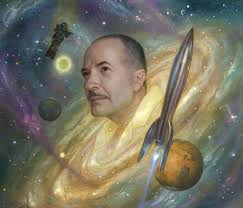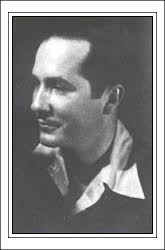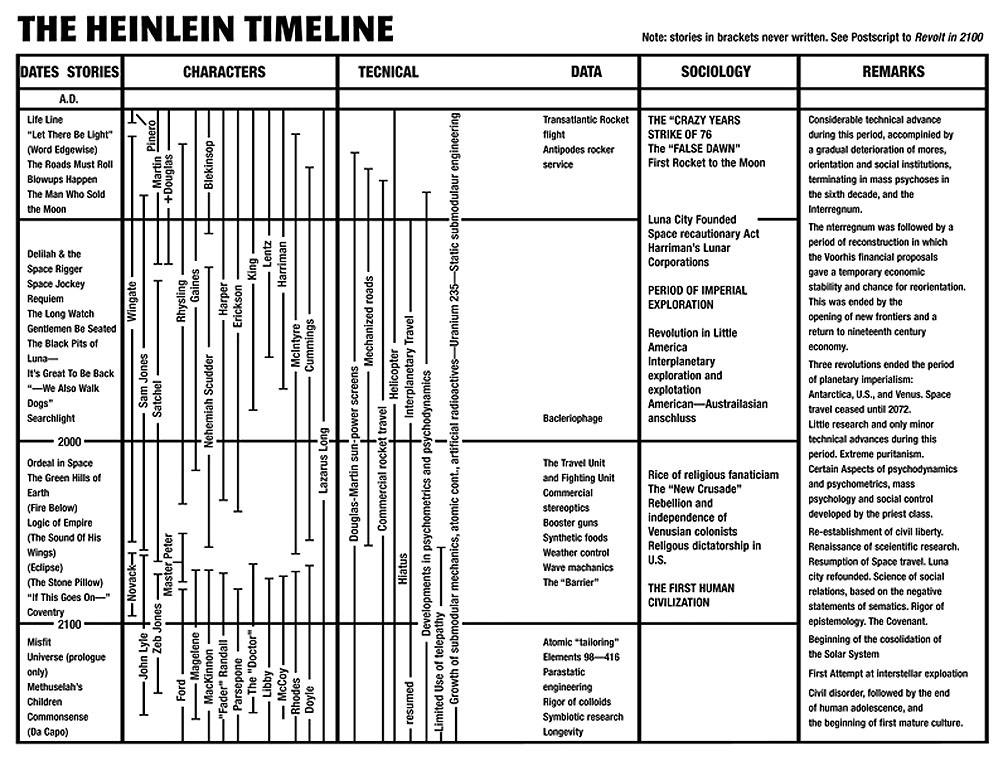No. 10 – 2013Mar10 – Robert Heinlein, The Moon is a Harsh Mistress, and Self-Reliance.
 As a Navy man, Heinlein recruited Isaac Asimov and L. Sprague de Camp into working at the Philadelphia Navy Shipyard. Like Asimov, Heinlein worked with Astounding Science Fiction magazine editor John W. Campbell, Jr. After selling Life-Line (1940 to Campbell), he wrote three short novels, four novelettes, and seven short stories in one year, dominating the SF field.
As a Navy man, Heinlein recruited Isaac Asimov and L. Sprague de Camp into working at the Philadelphia Navy Shipyard. Like Asimov, Heinlein worked with Astounding Science Fiction magazine editor John W. Campbell, Jr. After selling Life-Line (1940 to Campbell), he wrote three short novels, four novelettes, and seven short stories in one year, dominating the SF field.
 Some people don’t grok Robert Heinlein, but then, if they don’t read that’s hardly his fault. Heinlein is both a member of The Big Four of the Golden Age of Science Fiction (Sturgeon, Asimov, Heinlein, and van Vogt), he is also a member of The Big Three of Science Fiction (Isaac Asimov, Arthur C. Clarke, and Robert Heinlein.)
Some people don’t grok Robert Heinlein, but then, if they don’t read that’s hardly his fault. Heinlein is both a member of The Big Four of the Golden Age of Science Fiction (Sturgeon, Asimov, Heinlein, and van Vogt), he is also a member of The Big Three of Science Fiction (Isaac Asimov, Arthur C. Clarke, and Robert Heinlein.)
This last group is notable for how they incorporated science into their science fiction. They provided the science fiction genre a greater credence and plausibility, improving the popular image of science fiction as a whole. Heinlein, once described by Asimov as a ‘flaming liberal,’ may have swung toward the right, but never completely abandoned some liberal ideas like ‘free love.’ I should mention that Heinlein has a few notable series: The Juvenile Series, The Lazurus Long Series, The Future History Series, and World As Myth Series.
The Juvenile Series ends with Starship Troopers, one of the works he wrote for Charles Scribner’s Sons publishing during the fifties. It is an archetype of military science fiction written for the young adult market. He was really giving the middle-finger to leftists when they suggested that President Eisenhower should abandon nuclear testing. This was his last work of The Juvenile Series.
 Some believe the movie corrupted Heinlein’s tale by constructing a fascist society. The movie is riddled with combat scenes, but in the novel there are few instances of battle. A fundamental tenet of the book is that citizenship is earned primarily through Federal Service (primarily military service, but Heinlein included other types of service like teachers and police officers). The story is essentially a political essay on democracy, limited by Heinlein’s views on suffrage and meritocracy.
Some believe the movie corrupted Heinlein’s tale by constructing a fascist society. The movie is riddled with combat scenes, but in the novel there are few instances of battle. A fundamental tenet of the book is that citizenship is earned primarily through Federal Service (primarily military service, but Heinlein included other types of service like teachers and police officers). The story is essentially a political essay on democracy, limited by Heinlein’s views on suffrage and meritocracy.
 The Lazurus Long Series uses the oldest human as a conduit to explore Heinlein’s fondest ideas: free love, time travel, parallel dimensions, individualism, and the concept of World as Myth (theorizing that the act of imagining actually creates reality–handy for a fiction writer). Heinlein’s expressed views on individualism frequently involve Lazurus with the authorities, which he naturally detests.
The Lazurus Long Series uses the oldest human as a conduit to explore Heinlein’s fondest ideas: free love, time travel, parallel dimensions, individualism, and the concept of World as Myth (theorizing that the act of imagining actually creates reality–handy for a fiction writer). Heinlein’s expressed views on individualism frequently involve Lazurus with the authorities, which he naturally detests.
The Future History Series is primarily collected in The Past Through Tomorrow. Scholars tend to link Heinlein’s works to his Future History chart, the term coined by John W. Campbell, Jr. who first published this chart in Astounding Science Fiction magazine’s February issue in 1941.
My personal favorites are The Moon is a Harsh Mistress and Stranger in a Strange Land.
In The Moon is a Harsh Mistress, the moon is a ghetto of criminals and political malcontents banished to Luna for their own good. The Warden’s master computer, the Holmes IV, runs everything: air vents, door hatches, communication and security systems, cargo container orbital catapult: you name, it does it.
 The protagonist, a computer technician named Mannie, discovers this computer has a sense of humor. Naturally, he gives it a name: “Mike” for Mycroft Holmes, Sherlock’s brother. Given his penchant for jokes and humor, Mike finds excuses for Mannie to service him. Their collaboration leads Mannie into recording an anti-Authority meeting where Mike gets an education on human motivations. Mike eventually decides that the ‘Loonie’ revolutionaries have good reasons to rebel. He
The protagonist, a computer technician named Mannie, discovers this computer has a sense of humor. Naturally, he gives it a name: “Mike” for Mycroft Holmes, Sherlock’s brother. Given his penchant for jokes and humor, Mike finds excuses for Mannie to service him. Their collaboration leads Mannie into recording an anti-Authority meeting where Mike gets an education on human motivations. Mike eventually decides that the ‘Loonie’ revolutionaries have good reasons to rebel. He  becomes central to the revolution operation, becoming the revolutionary leader.
becomes central to the revolution operation, becoming the revolutionary leader.
Screenwriter Tim Minear has adapted the book to a screen play (2006), but no word on whether anyone’s interested in producing it.
 In Stranger in a Strange Land, the first expedition to Mars perishes, leaving an orphan, Michael Valentine Smith, to be raised by Martians. His new foster parents teach him Martians skills: complete control over his mind and body.
In Stranger in a Strange Land, the first expedition to Mars perishes, leaving an orphan, Michael Valentine Smith, to be raised by Martians. His new foster parents teach him Martians skills: complete control over his mind and body.
Twenty years later, a second expedition returns him to Earth. As heir to the Lyle fortune, (inventor of the Lyle Drive that makes interplanetary travel economical) he becomes a player in Earth geopolitics when an interpretation of law may grant him ownership rights to the planet Mars.
Debilitated by Earth’s higher gravity, he is confined to a hospital bed. When a nurse shares a glass of water with him, she inadvertently becomes a “water-brother,” a holy relationship on Mars.
Michael Valentine Smith is a vehicle for Heinlein to discuss religion. It’s an interesting discussion on theology by an outside observer of human culture, seen through the eyes of a human “alien” who is bereft of Earth’s cultural upbringing. Naturally, the protagonist has a unique perspective.
One of my earliest reads of Heinlein was Have Space Suit—Will Travel, a Juvenile Series work. Kip, the protagonist, enters a writing contest and his entry, a short advertising jingle, doesn’t win him a free trip to the Moon, but he does win a genuine, albeit used, space suit.
With a little help, the high school senior repairs the suit and makes it serviceable. As he’s taking his last walk, before selling the suit, the suit’s shortwave frequencies pick up a MayDay transmission from someone named “PeeWee.” Using his transmissions as a homing beacon, PeeWee, and her alien companion, nearly land on him. The three of them are captured and taken to the Moon as hostages by another alien with evil designs.
Harry Kloor, a Star Trek writer, has optioned an adaptation of this story. It was projected to be released this year, but no news yet about its fate.
 In the novel, Double Star, an actor (the Great Lorenzo) impersonates a noted political figure (Bonforte) who has been kidnapped. Lorenzo doesn’t like Bonforte or his demanding role of impersonating this politico. But when Bonforte is rescued, his poor health forces Lorenzo into continuing the charade. He plays out the role of Supreme Minister and runs for office. The political situation requires Lorenzo to overcome his own opposition to granting Martians suffrage rights, since Bonforte does, and Lorenzo must perform this unwelcome role.
In the novel, Double Star, an actor (the Great Lorenzo) impersonates a noted political figure (Bonforte) who has been kidnapped. Lorenzo doesn’t like Bonforte or his demanding role of impersonating this politico. But when Bonforte is rescued, his poor health forces Lorenzo into continuing the charade. He plays out the role of Supreme Minister and runs for office. The political situation requires Lorenzo to overcome his own opposition to granting Martians suffrage rights, since Bonforte does, and Lorenzo must perform this unwelcome role.
James Blish reviewed this work and, breaking with his usual pattern of harsh criticism of many of Heinlein’s characters, gives full marks to Lorenzo’s character for remaining true to himself throughout this novel.
Heinlein, along with some other SF writers like Wells, Sturgeon, Asimov, and Clarke may reflect social development in the modern world, but they also refract that development. They put their own spin on social evolution and consequently pushed it directions uniquely personal.
Heinlein was an odd bird for many of his contemporaries. On the one hand, he displayed great talent in incorporating science into his works. On the other hand, his social views irritated more than one editor, evidenced by the end of his association with Charles Scribner’s Sons and The Juvenile Series.
Heinlein’s life was bumpy with his health taking a nose dive on occassion, interupting his productivity. He also alienated various editors and fellow SF writers with his outlandish political views. His swing from the left to the right, politically, wasn’t a smooth one since he continued to espoused “free love.” His stories, his political views, and his lifestyle never wavered from one core belief and that was in self-reliance. There is something ephemeral, and primal, about his passion for self-reliance. Color it chauvinism, if you will, since it was both a fiercely defended American perspective on personal freedom and simultaneously a patriotic stance.
Many Libertarians believe that The Moon is a Harsh Mistress is one of the most important polemics on self-reliance and civil rights ever written. Numerous Heinlein works have underlying themes of self-reliance and individualism in them. The characters frequently make comments about liberty and that our authorities cannot be trusted.
 Whatever your personal perspective on Heinlein may be, he has left all of us with an interesting legacy of not just good science fiction, but political essays worth pondering, all within the same book covers. His legacy includes both the Robert Heinlein Have Space Suit — Will Travel (HSSWT) Educational Program and the Robert Heinlein Professorship at the United States Naval Academy at Annapolis, Maryland.
Whatever your personal perspective on Heinlein may be, he has left all of us with an interesting legacy of not just good science fiction, but political essays worth pondering, all within the same book covers. His legacy includes both the Robert Heinlein Have Space Suit — Will Travel (HSSWT) Educational Program and the Robert Heinlein Professorship at the United States Naval Academy at Annapolis, Maryland.
There’s a significant IF (internet footprint) on Robert Heinlein. Check out The Robert Heinlein Society and The Robert A and Virginia Heinlein Prize Trust.










